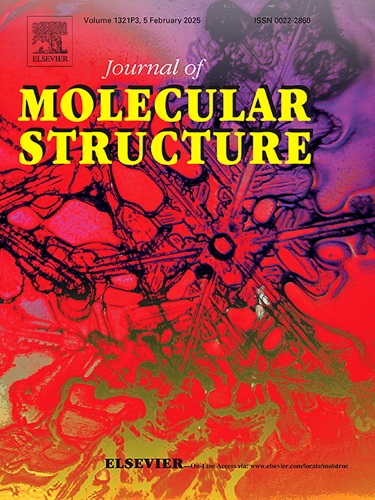一种新型酞酰肼衍生物作为多靶标荧光探针,用于监测水中的痕量 Co2+ 和 Cu2+
IF 4
2区 化学
Q2 CHEMISTRY, PHYSICAL
引用次数: 0
摘要
本文章由计算机程序翻译,如有差异,请以英文原文为准。

A novel phthalohydrazide derivative as a multi-targeted fluorescent probe for monitoring trace Co2+ and Cu2+ in water
Real-time monitoring of metal ion species and concentrations in water is a highly active research field. In the paper, a novel fluorescent molecule, (E)-N'-((5-(9-phenyl-9H-carbazol-3-yl) thiophen-2-yl) methylene) terephthalohydrazide (PCTMT), is synthesized via Suzuki reaction and Schiff-base reaction in turn. In the DMF-H2O (70 % v/v) solvent system, the PCTMT presents a good aggregation-induced enhancement (AIE) fluorescent effect and good selectivity and anti-interference for monitoring Co2+ and Cu2+ in water with a wide pH range. The probe's detection limit (LOD) reached 28.2 nM and 38.7 nM for Co2+ and Cu2+, respectively. The binding constants between PCTMT and Co2+ and Cu2+ are calculated as 1.8 ×1017 M-2 and 2.3 ×1016 M-2, at a 2:1 mol ratio. In the probe system, Co2+ and Cu2+can be distinguished by oxalate titration. The detection mechanism is discussed through testing analyses with the theoretical simulation calculation via the density functional theory (DFT) and time-dependent density functional theory (TD-DFT). The probe also indicates good detection capacities in real water samples. This study may promote the development of coordinated-type ion probes and innovation in water quality detection technology.
求助全文
通过发布文献求助,成功后即可免费获取论文全文。
去求助
来源期刊

Journal of Molecular Structure
化学-物理化学
CiteScore
7.10
自引率
15.80%
发文量
2384
审稿时长
45 days
期刊介绍:
The Journal of Molecular Structure is dedicated to the publication of full-length articles and review papers, providing important new structural information on all types of chemical species including:
• Stable and unstable molecules in all types of environments (vapour, molecular beam, liquid, solution, liquid crystal, solid state, matrix-isolated, surface-absorbed etc.)
• Chemical intermediates
• Molecules in excited states
• Biological molecules
• Polymers.
The methods used may include any combination of spectroscopic and non-spectroscopic techniques, for example:
• Infrared spectroscopy (mid, far, near)
• Raman spectroscopy and non-linear Raman methods (CARS, etc.)
• Electronic absorption spectroscopy
• Optical rotatory dispersion and circular dichroism
• Fluorescence and phosphorescence techniques
• Electron spectroscopies (PES, XPS), EXAFS, etc.
• Microwave spectroscopy
• Electron diffraction
• NMR and ESR spectroscopies
• Mössbauer spectroscopy
• X-ray crystallography
• Charge Density Analyses
• Computational Studies (supplementing experimental methods)
We encourage publications combining theoretical and experimental approaches. The structural insights gained by the studies should be correlated with the properties, activity and/ or reactivity of the molecule under investigation and the relevance of this molecule and its implications should be discussed.
 求助内容:
求助内容: 应助结果提醒方式:
应助结果提醒方式:


